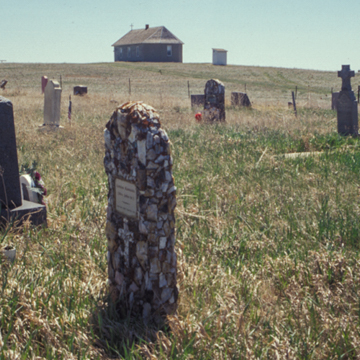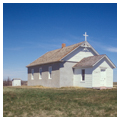The largest colonies of Black Sea Germans in the western portion of North Dakota were Catholic. But following the completion of rail lines through Mott, the southwestern lands in the vicinity of Elgin were claimed by Evangelical German Russians. Situated on a hill above an accompanying cemetery, this church is one of only two original church structures representing the settlement of Evangelical German Russian groups, and was built by twelve local families from the Beresan region of southern Russia. The church is a single-story gabled building with walls constructed of native sandstone slabs laid in mud mortar to a thickness of nearly two feet. The immigrants employed Old World building traditions based on the use of native materials such as sandstone, petrified wood, sun-dried mud bricks, and clay mortars. The exterior walls are finished in troweled cement plaster, which was applied in 1981 to approximate the texture of the original mixture of lime, sand, and flax straw. Entrance is through a gabled wood-frame vestibule. The gables are of wood-frame construction, extending slightly beyond the walls to form a shallow beadboard soffit. Gabled ends are clad in horizontal lap siding typical of German Russian house types built during the settlement period. Adjacent to the church is an interesting and powerful cemetery landscape, but given the ethnic and religious associations, this is not a prominent site for folk iron-cross cemetery markers.
You are here
Heuple Trinity Evangelical Lutheran, Old Stone Church
If SAH Archipedia has been useful to you, please consider supporting it.
SAH Archipedia tells the story of the United States through its buildings, landscapes, and cities. This freely available resource empowers the public with authoritative knowledge that deepens their understanding and appreciation of the built environment. But the Society of Architectural Historians, which created SAH Archipedia with University of Virginia Press, needs your support to maintain the high-caliber research, writing, photography, cartography, editing, design, and programming that make SAH Archipedia a trusted online resource available to all who value the history of place, heritage tourism, and learning.


















